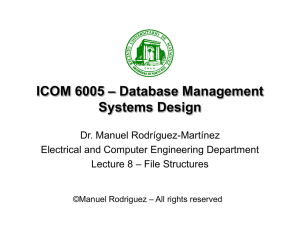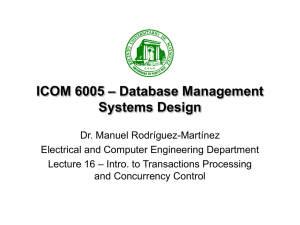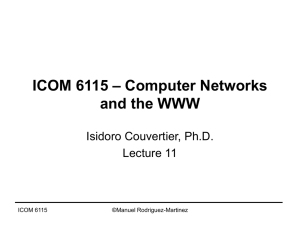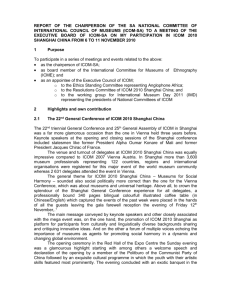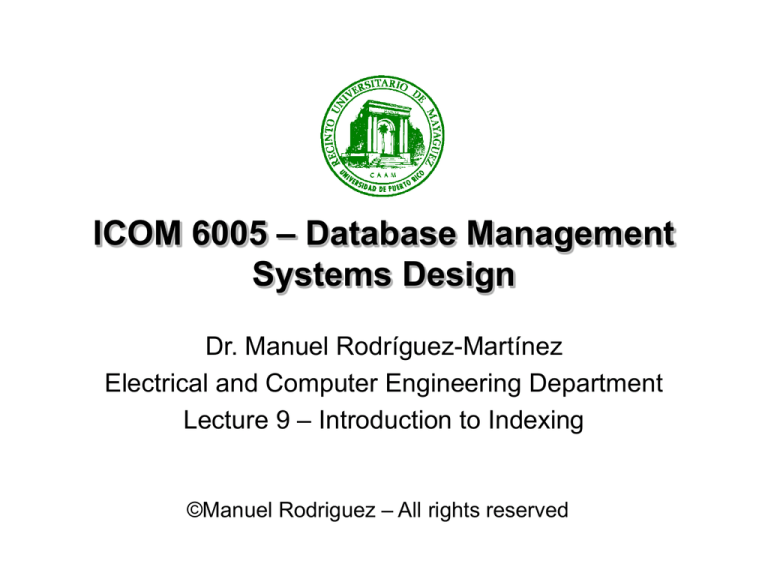
ICOM 6005 – Database Management
Systems Design
Dr. Manuel Rodríguez-Martínez
Electrical and Computer Engineering Department
Lecture 9 – Introduction to Indexing
©Manuel Rodriguez – All rights reserved
Readings
• Read
– New Book: Chapter 8
ICOM 6005
Dr. Manuel Rodriguez Martinez
2
Index File
121
Jil
NY
$5595
123
Bob
NY
$102
1237
Pat
WI
$30
100
2000
9000
Index entry
ICOM 6005
2381
Bill
LA
$500
4882
Al
SF
$52303
8387
Ned
SJ
$73
9403
Ned
NY
$3333
81982
Tim
MIA
$4000
Dr. Manuel Rodriguez Martinez
Data
entries
3
Index files structure
• Index entries
– Store search keys
– Search key – a set of attributes in a tuple can be used to
guide a search
• Ex. Student id
– Search key do not necessarily have to be candidate keys
• For example: gpa can be a search key on relation:
Students(sid, name, login, age, gpa)
• Data entries
– Store the data records in the index file
– Data record can have
• Actual tuples for the table on which index is defined
• Record identifier for tuples that match a given search key
ICOM 6005
Dr. Manuel Rodriguez Martinez
4
Issues with Index files
•
Index files for a relation R can occur in three forms:
1. Data entries store the actual data for relation R.
•
Index file provides both indexing and storage.
2. Data entries store pairs <k, rid>:
•
•
•
k – value for a search key.
rid – rid of record having search key value k.
Actual data record is stored somewhere else, perhaps on a
heap file or another index file .
3. Data entries store pairs <k, rid-list>
•
•
•
ICOM 6005
K – value for a search key
Rid-list – list of rid for all records having search key value k
Actual data record is stored somewhere else, perhaps on a
heap file or another index file.
Dr. Manuel Rodriguez Martinez
5
Clustered vs Unclustered Index
• Index is said to be clustered if
– Data records in the file are organized as data entries in the
index
– If data is stored in the index, then the index is clustered by
definition. This is option (1) from previous slide.
– Otherwise, data file must be sorted in order to match index
organization.
• Un-clustered index
– Organization on data entries in index is independent from
organization of data records.
– These are options (2) and (3)
• File storing a relation R can only have 1 clustered
index, but many un-clustered indices
– Why?
ICOM 6005
Dr. Manuel Rodriguez Martinez
6
Clustered Index
Index entries
Index
File
Data
entries
Records are stored at data entries
ICOM 6005
Dr. Manuel Rodriguez Martinez
7
Unclustered Index
Index
entries
Index
File
Data
entries
Data
File
ICOM 6005
Dr. Manuel Rodriguez Martinez
8
Some issues
• Primary index
– Index defined on the primary key of a relation
• Secondary index
– Index defined on one or more attributes that are not a key
• Other nomenclature
– Primary access method – access data as stored
• Primary index
• Index based on Index organization option (1)
– Secondary access method – alternative access to data
independent from native storage organization
• Secondary index
• Other methods such as sorting or hashing data into a
temporary file
ICOM 6005
Dr. Manuel Rodriguez Martinez
9
Hash-Based Indexing
• Hash the records on some attribute(s)
• Accumulate records with same hash into value into
same bucket
– Bucket has a primary page and additional pages are linked
in a list
• Hash function maps each record to a bucket
– Ex. int Hash(char *str, int len) {
int res = 0;
for (int j =0; j < len; ++j){
res+=str[i];
}
return res % NUMBER_BUCKETS;
}
ICOM 6005
Dr. Manuel Rodriguez Martinez
10
Hash Index (clustered)
H()
Account
attribute
ICOM 6005
121
Jil
NY
$5595
123
Bob
NY
$102
1237
Pat
WI
$30
2381
Bill
LA
$500
8387
Ned
SJ
$73
4882
Al
SF
$52303
9403
Ned
NY
$3333
81982
Tim
MIA
$4000
Dr. Manuel Rodriguez Martinez
11
Hash Index (Unclustered)
121
Jil
NY
$5595
123
Bob
NY
$102
1237
Pat
WI
$30
LA
NY
NY
2381
Bill
LA
$500
8387
Ned
SJ
$73
4882
Al
SF
$52303
city
NY
H()
MIA
SJ
9403
Ned
NY
$3333
SF
81982
Tim
MIA
$4000
WI
ICOM 6005
Dr. Manuel Rodriguez Martinez
12
Tree-Structured Index
30
…
…
Data
Entries
50
… …
110
90000
110
8500
1300
8100
122, Jil, NY, $5595
2381, Bill, LA, $500
123, Pat, WI, $30
3387, Ned, SJ, $73
127, Bob, NY,$102
4882, Al, SF, $52303
ICOM 6005
Dr. Manuel Rodriguez Martinez
Index on
account id
90000
100000
… … …
…
8301, Ned,NY,$3333
8498, Tim, MI, $400
13
Some issues
• Data entries are maintained at the leaf level
• Each index entries are stored in disk pages
• We want to keep root page of index in the buffer pool
while we are scanning the index
• In practice, finding data with an index will costs
– N I/Os to read the index entries in the path of the tree.
– K I/Os to read all the index entries
– Total N + K I/O operations
• Most DBMS system manage to keep path between 2
and 3!
– B+ tree
– Fan-out - number of children in index nodes
• Bigger means smaller tree height (smaller path to leaves!)
ICOM 6005
Dr. Manuel Rodriguez Martinez
14
Estimating cost for operations
• The following are the typical operation applied to
DBMS files (Heap, sorted, and index files)
– Scan: fetch all the records in the file
– Search with equality – find all records that satisfy an equality
clause
– Search with Range – find records all records that satisfy a
range condition
• Range queries
– Insert a record – add a new record to the file
– Delete a record – remove a record with a given rid from the
file.
ICOM 6005
Dr. Manuel Rodriguez Martinez
15

